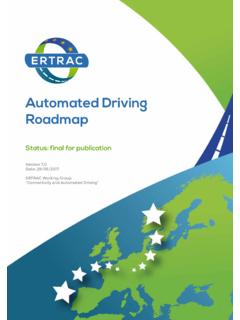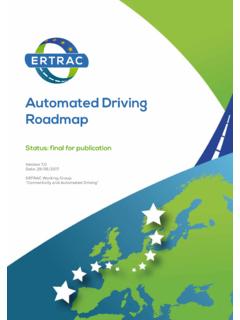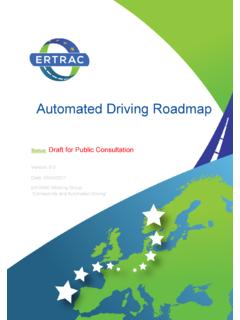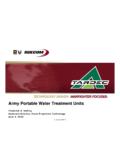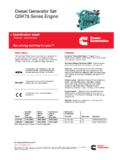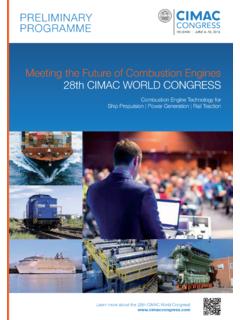Transcription of Future Light and Heavy Duty ICE Powertrain …
1 Future Light and Heavy duty ICE Powertrain Technologies Status: final for endorsement Version: Date: ERTRAC Working Group: Energy and Environment Page 2 of 75 Table of contents Table of contents .. 2 1 Introduction .. 5 Scenario and Future trends .. 5 Vision for the Future of internal combustion engines .. 6 The role of the EU collaborative 7 Impact so far from collaborative research ..8 2 EU road transportation scenario .. 10 EU Climate and Energy Framework ..10 ERTRAC s Perspective ..11 The European industry and market perspective.
2 15 3 Challenges and technology potential for ICE based powertrains and the impact of new ICE technologies .. 18 ICEs in general ..18 Light duty ICE ..20 Air Quality Enhancement ..22 CO2 challenges for Future Heavy duty ICEs ..23 The role of alternative fuels ..26 4 Conclusions and impact .. 29 5 References .. 31 6 Technical Annex .. 32 ICE Technologies ..32 Current level of development (State of the Art) .. 33 Research Needs and impact of the successful implementation of the technology .. 34 Air and exhaust gas management.
3 35 Fuel preparation & injection system : .. 36 Thermodynamic combustion engine process .. 37 ICE Control Systems .. 38 Exhaust Gas Aftertreatment (EAT) ..40 State of the art .. 40 Research needs .. 41 Page 3 of 75 Gasoline Vehicles .. 41 Diesel Vehicles .. 43 Natural Gas Vehicles .. 44 Modelling/Simulation .. 45 Waste heat recovery ..45 State of the art .. 46 Research needs .. 48 Organic Rankine Cycle .. 48 Thermoelectric Generators .. 48 Turbocompounding .. 49 Advanced Heat Exchangers .. 49 Multi-temperature Radiator.
4 50 Water charge air cooler Intercooler .. 50 Nanofluids (nanocoolant) .. 51 Improvement to fan drive systems .. 51 Integrated transmission and engine oil cooling circuit .. 51 Engine Encapsulation .. 52 Organic Rankine Cycle .. 52 Thermoelectric Generators .. 53 Turbocompounding .. 54 Powertrain and vehicle thermal management .. 54 Powertrain thermal management .. 55 Integrated vehicle thermal management .. 56 Advanced Heat Exchangers .. 56 Multi-temperature Radiator .. 57 Water charge air cooler Intercooler .. 58 Nanofluids (nanocoolant).
5 58 Improvement to fan drive systems .. 59 Integrated transmission and engine oil cooling circuit .. 59 Engine Encapsulation .. 60 Transmissions ..60 State of the Art .. 61 Research needs .. 64 Manual transmission .. 65 Automated manual transmission .. 66 Heavy truck transmission .. 67 Dual Clutch Transmission (DCT) .. 69 Page 4 of 75 Automatic transmission (AT, epicyclic gear train) .. 70 Continuously variable transmissions (CVT) .. 72 Transmission control .. 72 Transmissions for electric vehicles .. 74 Page 5 of 75 1 Introduction Scenario and Future trends The Mobility of people and transportation of goods are fundamental needs of modern society.
6 Any approach to fulfil these needs must meet sustainability criteria in addition to achieving customer acceptance. Accordingly solutions and services have to comply with safety, energy efficiency and security, environmental compatibility and affordability criteria. To fulfil these criteria, the evolution of the transportation system will advance by combining improvements and changes in Powertrain and vehicle technologies in close connection with fuels & energy scenario development. The already developing electrification of the Powertrain will continue progressing according to the different vehicle development goals, whilst the need to increase the energy security and to reduce the use of fossil and oil based fuels will push for a wider use of renewable energy sources.
7 Based on a global need this process will be deployed at local level according to the availability of raw materials and local policies. Long term trends related to the evolution of personal mobility needs, but also in relation to goods transportation, will participate in shaping the market portfolio of transport solutions. More people are expected to live in large agglomerations and they will continue ask for clean and efficient solutions. This clean factor will be provided not only by vehicle technological advances but also by the optimisation of their use thanks to the increasing role of connectivity.
8 Likewise the long haul transportation system will benefit both from connectivity, which will enhance automated driving conditions especially on intercity and highway routes, and from a wider diffusion of intermodal model schemes. Based on long-term planning information from industrial partners ERTRAC s Strategic Research Agenda expects that 60% or more of the new passenger vehicles in Europe will still be powered by an Internal Combustion Engine (ICE). Even in the long term horizon until 2050: Powertrain applications will include ICE, Hybrids, Range Extender architectures as well as dedicated alternative fuels ( Natural Gas) engines.
9 Similarly the Heavy duty market is expected to be dominated by ICE for some time to come given the need for energy density in the propulsion of larger vehicles. The mid-term trend until 2030 and the long-term trend up to 2050 will depend on several technical and political events that will drive on the one hand the progress of the current technologies and, on the other hand, the take-off of new solutions. Concerning the first aspect: New combustion processes and technologies to make ICE even cleaner, efficient and cost competitive are expected to be developed to support the integration of new hybrid architectures.
10 They will also derive the maximum Page 6 of 75 benefit from the use of clean, alternative fuels. In parallel, political measures put in place to comply with air quality legislation for large cities could lead to acceleration towards clean powertrains based on electric propulsion or alternative fuels and a consequent limitation in the use of conventional ICEs. Nevertheless, considering and targeting a larger use of electric driven powertrains in the Future ( by car sharing services), this transition process still requires improvements in battery energy density, the development of the appropriate grid and the charging infrastructure as crucial elements for an effective market penetration of electric vehicles, including improvements in cost effectiveness as well as technology.
